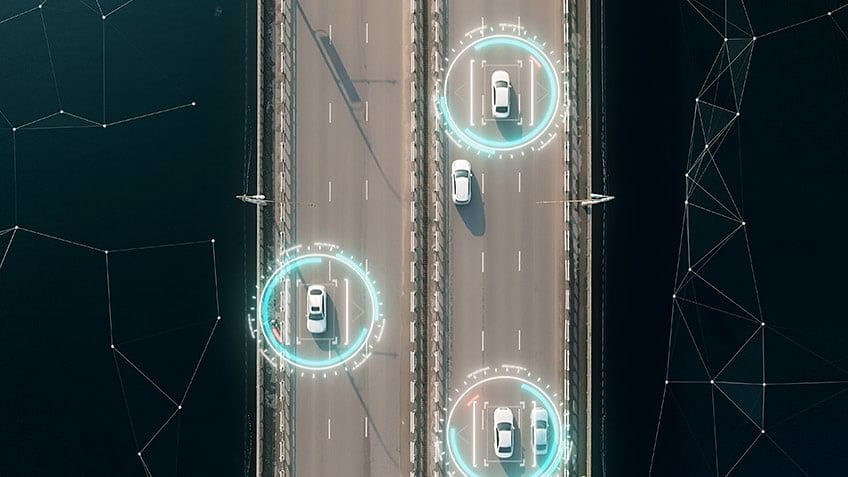Smart Roads: Everything You Need to Know
Smart Roads: Everything You Need to Know

Think of smart roads as autonomous vehicles’ (AVs) silent partner. Improving smart infrastructure on our roadways not only will help AVs navigate roads better and safer, but it will also enhance the entire transportation system’s performance.
AVs are touted as safer than human-driven vehicles since most accidents are due to human error. But before AVs are market-ready, technology advances are still needed to improve the vehicles’ ability to see around obstacles such as trucks and to anticipate pedestrian and vehicle movement.
For Construction Pros argues that smart roads are just as important as smart vehicles. The focus should go beyond AV technology to include upgrading the existing road infrastructure. Although some AV manufacturers don’t rely on smart roads, the publication says their development can play an important role in speeding up the adoption of AVs.
What Are Smart Roads?
Intel says that cities can gather data with internet-of-things (IoT) technologies to manage traffic and plan for future transportation better. These devices include speed sensors, acoustic sensors, IP CCTV cameras, smart traffic lights, condition/weather monitoring systems, and digital signage. Data from IoT sensors, cameras, and radar, can be used in real-time to ease traffic flow. This data also can be used to reduce pollution and improve road conditions.
For Construction Pros reports that in Miami-Dade County, Florida, Ford’s AV team is looking at how smart infrastructure can feed AV data before it arrives at an intersection. In Las Vegas, Motional’s driverless vehicles work with Derq to provide a “bird’s-eye view” for AVs at some of that city’s busiest intersections.
Smart Road Benefits
Smart roads could benefit cities in numerous ways:Reducing congestion – Monitoring vehicle movement and adjusting traffic lights can help reduce traffic jams. On Arizona’s Bell Road Highway, the GRIDSMART System, powered by Intel® Core™ processors, uses computer vision to monitor intersections and collect near real-time traffic data. The system reduced delays by 20 percent on weekdays and 43 percent on weekends.
Improving safety – Computer vision can help detect and avoid other vehicles, pedestrians, and bicyclists. Smart devices also can alert first responders in the event of a crash or criminal activity. Intel worked with German industrial manufacturers to improve AV agility, vehicle safety, and traffic flow. Using Intel® Xeon® processors inside edge nodes, the project transmitted traffic information to oncoming vehicles on a highway between Munich and Nuremberg, and identified potential risks.
Charging toll fees – E-tolling can automatically charge highway and bridge tolling fees using license plate recognition. Intel worked with Shenzhen JHC Technology Development Co. to develop a toll-collecting system to detect and identify vehicles automatically, without slowing or stopping vehicles. The technology reduces congestion and keeps traffic moving.
Detecting and avoiding problem areas – Smart roads can provide analytics about intersections and roadways with a high collision. It can help planners determine what mitigating measures to take, such as signals, signage, or speed limit changes.
Monitoring road conditions – With smart roads, cities can monitor and repair pavement conditions more timely.
Reducing pollution – Idling engines produce a lot of pollution. Smart road technology can help optimize traffic flow to prevent traffic jams.
Web Site : sensors.sciencefather.com
Visit Web Site : sciencefather.com
Nomination Link : https://sensors-conferences.sciencefather.com/award-nomination/?ecategory=Awards&rcategory=Awardee
Contact as : sensor@sciencefather.com
Social Media
Twitter :https://x.com/sciencefather2
Pinterest : https://in.pinterest.com/business/hub/
Linkedin : https://www.linkedin.com/feed/
#ScienceFather, #Researchaward,#ArtificialIntelligence, #AI, #MachineLearning, #DataScience, #BigData, #DeepLearning, #NLP, Natural Language Processing #ClimateResilience, #GreenAgriculture, #FoodSecurity, #SustainableDevelopment, #AgriTech, #RegenerativeFarming, #CarbonSequestration, #ClimateAction, #ResilientFarming, #PrecisionAgriculture, #SmartFarming, #Agroecology, #SoilHealth, #WaterManagement, #AdaptationAndMitigation, #EcoFriendlyFarming, #AgriculturalSustainability #EnvironmentalSafety, #MiningHealth, #ConfinedSpaceSafety, #SustainableVentilation #DigitalHealth #PrincipalInvestigator, #ClinicalResearchCoordinator, #GrantWriter, #R&DManager, #PolicyAnalyst, #TechnicalWriter, #MarketResearchAnalyst, #EnvironmentalScientist, #SocialScientist, #EconomicResearcher, #PublicHealthResearcher, #Anthropologist, #Ecologist,
.jpg)
Comments
Post a Comment